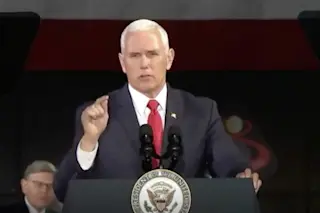In a speech to the National Space Council on Tuesday, Vice President Mike Pence said America should put an astronaut back on the moon in the next five years. (Credit: NASA) The Trump administration wants to put Americans back on the moon by 2024, Vice President Mike Pence announced Tuesday at a meeting of the National Space Council in Huntsville, Alabama. "The first woman and the next man on the moon will both be American astronauts launched by American rockets from American soil,” he pledged. It's an audacious pledge, given NASA's current capabilities, and especially in light of recent setbacks to the Space Launch System (SLS), the agency's long-delayed and over-budget heavy lift rocket. If NASA faces difficulties with that timeline, Pence said, “We need to change the organization, not the mission.” How this will affect NASA’s wide host of other goals, from astrophysics to education, remains unknown.
Pence acknowledged ...














